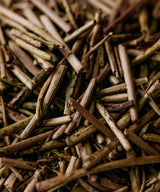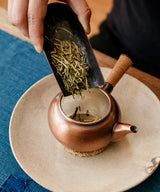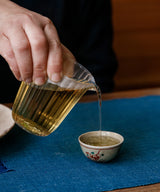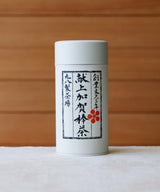Kenjo Kaga Bocha
献上加贺棒茶
Origin
Kaga, Ishikawa
Maruhachi Tea Factory was founded in Kaga, Ishikawa Prefecture in 1863. This tea factory has been making the finest roasted teas for six generations, from the Edo Period to the present day. Kago Bocha specifically has been crafted in Ishikawa Prefecture since the Meiji period!
Between the Edo Period and the Showa Period, tea trees were cultivated in what is now Kaga City of Ishikawa Prefecture. Tea production was quite large at the time, and many teas from Kaga were exported to the US. At this scale of production, tea leaves were harvested by machine; a process in which the stems are mixed in with tea leaves. After machine harvest, the leaves must be separated from the stems in order to make sencha, gyokuro and matcha. It came to be that the leftover stems were roasted and enjoyed by the local people of Kaga: this is the origin of “stem tea,” or bocha.
After many years of practice with roasting tea, Maruhachi Tea Factory was asked to produce the finest quality bocha for Emperor Showa, the 124th emperor of Japan, who happened to favour roasted teas as he grew older.
To do so it is essential to use high quality stems. There are even names for different grades of stems in Japan. The highest grade, and the ones Maruhachi sourced for the emperor’s tea, are called miruibo, which means “young, soft and fresh.” High-grade stems are difficult to source in large quantities, as they are not specifically grown to be made into tea since bocha originated as a way to make use of the by-product. There are only a few farmers in Japan that produce stems of high enough quality to be made into the finest kaga bocha. These stems will be soft and tender, and come from only the first harvest leaves.
What gives kaga bocha its clean and complex fragrance is the traditional roasting method the young stems go through. There are two methods of roasting tea in Japan. One is the direct-fire method, in which tea leaves and/or stems are roasted directly on a hot iron plate. The second, and more time consuming one, is a sand-roasting method by which leaves and stems are mixed with sand, and then roasted. In this way, the tea is heated slowly and indirectly by the radiating sand. The warm sand gradually transfers heat to the center of the tender stems, bringing out the umami and complexity of first harvest tea without over-roasting. With the direct-fire method, the one most commonly used for hojichas, the roasted tea has a strong aroma and taste, and brews a dark liquor. With sand-roasting, the tea liquor is lighter in colour, and has a more nuanced aroma and taste.
Since being founded in 1863, Maruhachi Tea Factory has only ever made bocha using the sand-roasting method. Nowadays, with consideration for food safety, instead of sand Maruhachi uses customized ceramic heaters that slowly roast the stems to the core, just as the sand would.
This amazing tea from Maruhachi Tea Factory resides in a category of its own – it is unlike anything we have ever tasted, and seems to float between categories of tea we’re more familiar with. It can even be enjoyed brewed hot or cold.
The flavour of kaga bocha is surprisingly soft and gentle, while still having a lot of body. The wet tea smells like tobacco leaf, ashed cigar, and pandan. As we drink it, these aromatics settle in the center of our palate and move upwards to fill our head. The sensation is so vaporous, it may feel like you are smoking it.
We could call this tea “Cultivate’s Bocha,” as it reminds us of what we love about pu’erh: it is deep, it continues to surprise us, and as it does, invites openness and consideration… How could something be so gentle and, at the same time, wholly encompassing?
Net weight 60g
. . .
Hot Brewing Guide
| Tea | 4g |
| Water | 180ml |
| Temperature | 100 °C |
| Steep time | 20 sec - 90 sec |
| No. of infusions | 6 |
Cold Brew Guide
| Tea | 3g |
| Water | 12 oz |
| Temperature | Room temperature filtered water |
| Steep | 3-6 hours in the fridge |
| No. of infusions | 1 |












